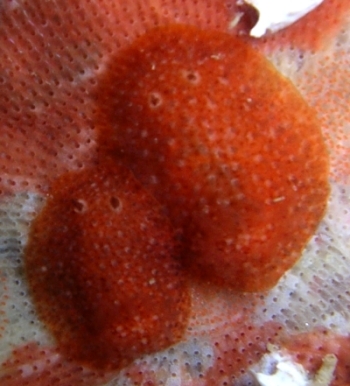
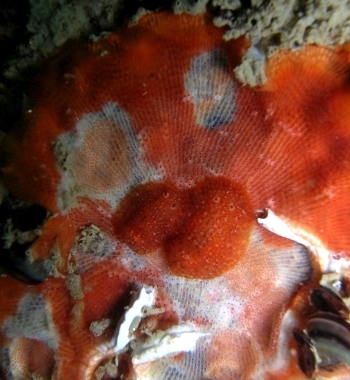
Onchidoris neapolitana
(Delle Chiaje, 1841)
Order: NUDIBRANCHIA
Suborder: DORIDINA
Superfamily: ANADORIDOIDEA
Family: Onchidorididae
DISTRIBUTION
Mediterranean and European coast as far north as Great Britain.
PHOTO
Numana, 10 metres, Italy, Adriatic sea, 15 April 2006, Shipwreck. Length: 5 - 10 mm. Photographer: Cristian Magnani.
Flattened and soft oval body. Mantle covered with soft finger-like retractile papillae. The body and mantle is translucent yellowish with a brown or reddish tinge all over. Ros (1975) reports it to feed on a variety of encrusting bryozoans while Sanchez-Santos (2005) reports it feeding on the red bryozoan Schizobrachiella sanguinea. Grows to approximately 8 mm
-
Ros, J. (1975). Opistobranquios (Gastropoda: Euthyneura) del litoral ibérico. Investigación Pesquera (Consejo Superior de Investigaciones Cientificas, Patronado Juan de la Cierva, Barcelona ), 39(2): 269-372, pls. 1-4.
-
Sanchez-Santos, A. (2005) Onchidoris neapolitana (Delle Chiaje, 1844) (Gastropoda: Nudibranchia: Onchidorididae): una nueva especie de molusco para la fauna andaluza. Iberus, 23: 43-48.
-
Schmekel, L. & Portmann, A (1982) Opisthobranchia des Mittelmeeres, Nudibranchia und Saccoglossa. Fauna e Flora del Golfo Napoli, 40: 1-410. Springer-Verlag: Berlin
Rudman, W.B., 2006 (April 26) Onchidoris neapolitana (Delle Chiaje, 1841). [In] Sea Slug Forum. Australian Museum, Sydney. Available from http://www.seaslugforum.net/find/onchneap
Related messages
Re: Onchidoris neapolitana from the Adriatic Sea
April 16, 2008
From: Borut Mavric
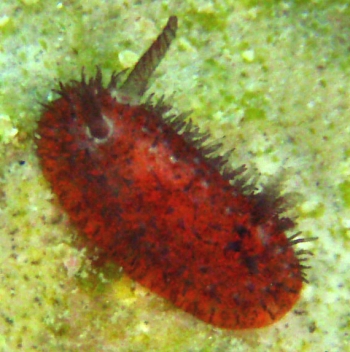
Concerning message #16434:
Dear Dr. Rudman,
On 27 February we found a red colored sea slug on a bryozoan covered stone. It was found at depth of cca. 4 m in the sea grass meadow of Cymodocea nodosa. The specimen measure was around 5 mm in total length. We checked the Sea Slug Forum for identification and now we think it's Onchidoris neapolitana.
Although we (the Marine Biological Station in Piran) have been collecting evidence of different sea slugs in the area for almost a decade, this is the first record of such species. We would be very grateful if you can help us to solve this identification problem or to confirm our findings.
Locality: Piran, 4 m, Slovenia, Northern Adriatic Sea, 27 February 2008, bryozoan covered stone among Cymodocea nodosa. Length: max 5 mm. Photographer: Borut Mavric.
Greetings from Piran,
prof. dr. L. Lipej & B. Mavric
mavric@mbss.org
Mavric, B., 2008 (Apr 16) Re: Onchidoris neapolitana from the Adriatic Sea. [Message in] Sea Slug Forum. Australian Museum, Sydney. Available from http://www.seaslugforum.net/find/21530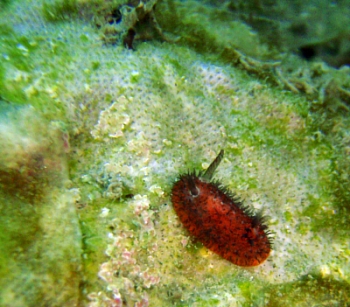
Dear Borut,
From your photos and its presence on the bryozoan colony, I would agree it is most probably Onchidoris neapolitana. I am sure Lucas Cervera will kindly let us know if it isn't.
Your location reminded me of an all too short visit I made to Slovenia after attending Heike Wagele's Opisthobranch Workshop in Bonn in 2006. It is definitely one of the beautiful secrets of Europe.
Best wishes,
Bill Rudman
Re: Onchidoris neapolitana from the Adriatic Sea
May 9, 2006
From: Cristian Magnani
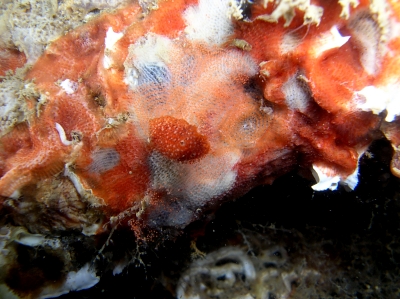
Concerning message #16434:
Dear Bill
In order to get some more information about this Onchidoris, i went back on the shipwreck where we first saw this nudibranch ( in spite the red bryozoan being very common in the area, this shipwreck is the only spot where these Onchidoris are commonly seen...actually i do not know why)
I took some photos of an Onchidoris with its eggs.
Locality: Numana, 10, Italy, Adriatic Sea, 06 May 2006, Shipwreck. Length: 8 mm. Photographer: Cristian Magnani.
Sorry, the quality is not very high but it was an uncomfortable place..
thanks for your help
Best wishes from Italy
Cristian
cristianmagnani@hotmail.com
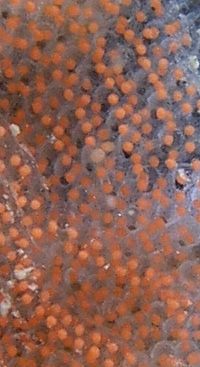
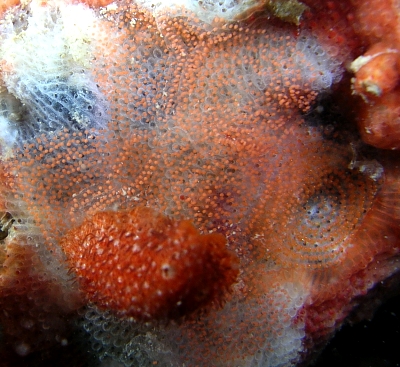
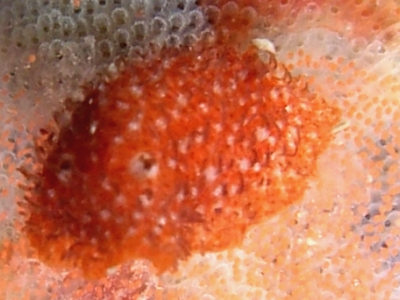
Dear Cristian,
Thanks for these photos. Although we all appreciate perfect photos, the Forum is not a photo competition, so I am very grateful for any photos, especially of rarely photographed animals like this. And specially when they show interesting biological information. We can see from your photos that this animal prefers to lay its eggs on parts of the bryozoan colony in which the living zooids have been removed. This has led to a bit of overcrowding and laying of one egg spiral over the top of others. I am not sure what that does to the survival prospects of an egg which ends up at the bottom of the pile.
The other interesting thing is that one of your photos - by luckily being a little out of focus - shows the flexible papillae which cover the back of this species quite clearly. These were not so clear in your last message. To those of you who don't do much photography, one of the problems with photographing small animals with long body projections is that as you increase the magnification of your photo, you are able to get less and less of the animal in sharp focus. Even with manual focus it is difficult to judge what to focus on to get a good photo and in 'uncomfortable' places like Cristian was working in, it is often impossible. So you have to decide whether to focus on the body, or the papillae, or the egg ribbons and just hope the rest of the photo is not too blurred.
Thanks again for sharing these photos with us,
Bill Rudman
Onchidoris neapolitana from the Adriatic Sea
May 1, 2006
From: Cristian Magnani
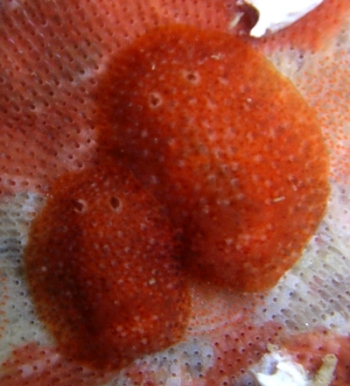
Hi Bill
Recently we witnessed a massive presence of a nudibranch that was identified as Onchidoris neapolitana by Lucas Cervera ( thanks Lucas for your help!)
Since I wasn't able to find any picture of this animal I thought it would be nice to share these ones with other enthusiasts. They are easily found on their food bryozoan, as shown in pictures
Locality: Numana, 10 metres, Italy, Adriatic sea, 15 April 2006, Shipwreck. Length: 5 - 10 mm. Photographer: Cristian Magnani.
Best regards
Cristian
cristianmagnani@hotmail.com
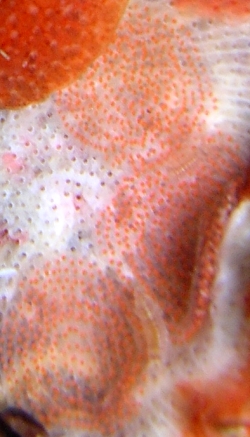
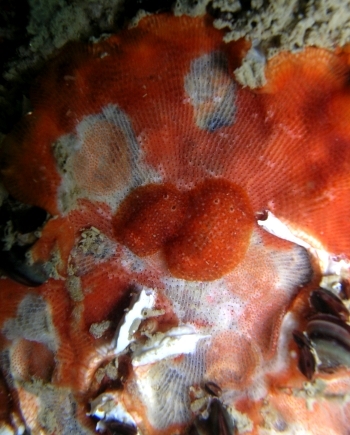
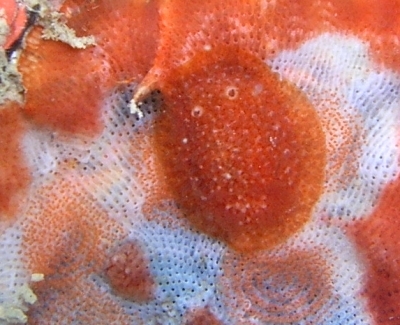
Dear Cristian,
Thanks for this new species for the Forum. It looks a bit like a red variety of Onchidoris depressa. Your animals have certainly been eating through this red bryozoan colony and are filling the white spaces with their eggs. The white spaces are areas of the colony where the nudibranch has eaten off all the red animal tissue leaving only the calcified skelelton. Ros (1975) lists quite a few species of bryozoans as their food, including species of Chorizopora, Cribrilaria, Escharina, Microporella, Parasmittina, Schismopora, Schizobrachiella, Schizomavella, Schizoporella, Smittoidea and Tubulipora.Sanchez-Santos (2005) reports it feeding on the red bryozoan Schizobrachiella sanguinea, which is possibly the bryozoan in your photos.
It's good to get the photos of the egg ribbons.
-
Ros, J. (1975). Opistobranquios (Gastropoda: Euthyneura) del litoral ibérico. Investigación Pesquera (Consejo Superior de Investigaciones Cientificas, Patronado Juan de la Cierva, Barcelona ), 39(2): 269-372, pls. 1-4.
-
Sanchez-Santos, A. (2005) Onchidoris neapolitana (Delle Chiaje, 1844) (Gastropoda: Nudibranchia: Onchidorididae): una nueva especie de molusco para la fauna andaluza. Iberus, 23: 43-48.
Best wishes,
Bill Rudman
